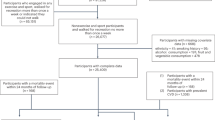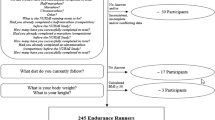Abstract
The aim of this review is to determine whether physical fitness, assessed by peak oxygen uptake (VO2peak) measurement, is reduced in survivors of acute lymphoblastic leukemia (ALL) compared to healthy children. A systematic literature search (up to June 2004) was performed using Medline, Sportdiscus, Cinahl, Embase, Cochrane and PEDro database and reference tracking. The VO2peak (ml kg−1 min−1) reached during a maximal exercise test until volitional exhaustion was used as the main outcome for this review. In all, 17 studies were identified in the literature. Data from three studies (102 ALL survivors, age ranging from 7 to 19 years) were pooled in a meta-analysis. Although there was a significant heterogeneity between the included studies (P=0.0006), the standardized mean difference (SMD) value of −0.61 (P=0.07) indicated that VO2peak tended to be reduced in survivors of childhood ALL compared to healthy control subjects, that is, decrease of −5.97 ml kg−1 min−1 (95% confidence interval (CI): (−12.35, 0.41); P=0.07) or −13% (95 % CI: (−27, 0.004)). Physical fitness tends to be reduced in survivors of ALL during childhood, which suggests the need for this population group to engage in regular physical activities with the purpose of increasing their functional capacity. Although more research is needed, this functional improvement might ameliorate the quality of life of ALL survivors as physical and outdoors activities are an essential part of daily routine during childhood.
This is a preview of subscription content, access via your institution
Access options
Subscribe to this journal
Receive 12 print issues and online access
$259.00 per year
only $21.58 per issue
Buy this article
- Purchase on Springer Link
- Instant access to full article PDF
Prices may be subject to local taxes which are calculated during checkout
Similar content being viewed by others
References
Shephard RJ, Allen C, Benade AJ, Davies CT, Di Prampero PE, Hedman R et al. The maximum oxygen intake. An international reference standard of cardiorespiratory fitness. Bull World Health Organ 1968; 38: 757–764.
McArdle WD, Katch FI, Katch VL (eds). Exercise Physiology. Energy, Nutrition and Performance, 5th edn. Philadelphia, PA: Lippincott Williams & Wilkins, 2001, pp 174–186.
Blair SN, Kampert JB, Kohl III HW, Barlow CE, Macera CA, Paffenbarger Jr RS et al. Influences of cardiorespiratory fitness and other precursors on cardiovascular disease and all-cause mortality in men and women. JAMA 1996; 276: 205–210.
Myers J, Prakash M, Froelicher V, Do D, Partington S, Atwood JE . Exercise capacity and mortality among men referred for exercise testing. N Engl J Med 2002; 4: 793–801.
Foster C, Cadwell K, Crenshaw B, Dehart-Beverley M, Hatcher S, Karlsdottir AE et al. Physical activity and exercise training prescriptions for patients. Cardiol Clin 2001; 19: 447–457.
Lucia A, Earnest C, Perez M . Cancer-related fatigue: can exercise physiology assist oncologists? Lancet Oncol 2003; 4: 616–625.
Dimeo F, Stieglitz RD, Novelli-Fischer U, Fetscher S, Keul J . Effects of physical activity on the fatigue and psychologic status of cancer patients during chemotherapy. Cancer 1999; 85: 2273–2277.
MacVicar MG, Winningham ML, Nickel JL . Effects of aerobic interval training on cancer patients' functional capacity. Nurs Res 1989; 38: 348–351.
Burham TR, Wilcox A . Effects of exercise on physiological and psychological variables in cancer survivors. Med Sci Sports Exerc 2002; 34: 1863–1867.
Oldervoll LM, Kaasa S, Knobel H, Loge JH . Exercise reduces fatigue in chronically fatigued Hodgkins disease survivors – results from a pilot study. Eur J Cancer 2003; 39: 57–63.
Vizinova H, Malincikova J, Klaskova E, Wiedermann J . Exercise cardiorespiratory indexes in children motivated to physical activity after treatment for acute lymphoblastic leukemia. Cas Lek Cesk 2002; 141: 491–493.
Hauser M, Gibson BS, Wilson N . Diagnosis of anthracycline-induced late cardiomyopathy by exercise-spiroergometry and stress-echocardiography. Eur J Pediatr 2001; 160: 607–610.
Matthys D, Verhaaren H, Benoit Y, Laureys G, De Naeyer A, Craen M . Gender difference in aerobic capacity in adolescents after cure from malignant disease in childhood. Acta Paediatr 1993; 82: 459–462.
Warner JT, Bell W, Webb DK, Gregory JW . Relationship between cardiopulmonary response to exercise and adiposity in survivors of childhood malignancy. Arch Dis Child 1997; 76: 298–303.
Ostanski M, Sonta-Jakimczyk D . Exercise tolerance in patients after acute lymphoblastic leukemia treatment in childhood. Wiad Lek 2001; 54: 650–655.
Black P, Gutjahr P, Stopfkuchen H . Physical performance in long-term survivors of acute leukaemia in childhood. Eur J Pediatr 1998; 157: 464–467.
Kadota RP, Burgert Jr EO, Driscoll DJ, Evans RG, Gilchrist GS . Cardiopulmonary function in long-term survivors of childhood Hodgkin's lymphoma: a pilot study. Mayo Clin Proc 1988; 63: 362–367.
Lipshultz SE, Colan SD, Gelber RD, Perez-Atayde AR, Sallan SE, Sanders SP . Late cardiac effects of doxorubicin therapy for acute lymphoblastic leukemia in childhood. N Engl J Med 1991; 324: 808–815.
Pihkala J, Happonen JM, Virtanen K, Sovijarvi A, Siimes MA, Pesonen E et al. Cardiopulmonary evaluation of exercise tolerance after chest irradiation and anticancer chemotherapy in children and adolescents. Pediatrics 1995; 95: 722–726.
Calzolari A, Baronci C, Biondi A, Donfrancesco A, Franti L, Miano C et al. Evaluation of a group of leukaemic children ‘off-therapy’, towards their inclusion in physical activities. Int J Sports Cardiol 1985; 2: 108–115.
Turner-Gomes SO, Lands LC, Halton J, Hanning RM, Heigenhauser GJ, Pai M et al. Cardiorespiratory status after treatment for acute lymphoblastic leukemia. Med Pediatr Oncol 1996; 26: 160–165.
Zalewska-Szewczyk B, Lipiec J, Bodalski J . Late cardiotoxicity of anthracyclines in children with acute leukemia. Klin Padiatr 1999; 211: 356–359.
Johnson D, Perrault H, Fournier A, Leclerc JM, Bigras JL, Davignon A . Cardiovascular responses to dynamic submaximal exercise in children previously treated with anthracycline. Am Heart J 1997; 133: 169–173.
Prestor VV, Rakovec P, Kozeli M, Jereb B . Late cardiac damage of anthracycline therapy for acute lymphoblastic leukemia in childhood. Pediatr Hematol Oncol 2000; 17: 527–540.
Jenney ME, Faragher EB, Jones PH, Woodcock A . Lung function and exercise capacity in survivors of childhood leukaemia. Med Pediatr Oncol 1995; 24: 222–230.
Sharkey AM, Carey AB, Heise CT, Barber G . Cardiac rehabilitation after cancer therapy in children and young adults. Am J Cardiol 1993; 71: 1488–1490.
Bassett DR, Howley ET . Limiting factors for maximum oxygen uptake and determinants of endurance performance. Med Sci Sports Exerc 2000; 32: 70–84.
Richardson RS, Grassi B, Gavin TP, Haseler LJ, Tagore K, Roca J et al. Evidence of O2 supply-dependent VO2max in the exercise-trained human quadriceps. J Appl Physiol 1999; 86: 1048–1053.
McKenzie DC, Coutts KD, Rogers PC, Jespersen DK, Pretula A . Aerobic and anaerobic capacities of children and adolescents successfully treated for solid tumors. Clin Exerc Physiol 2000; 2: 39–42.
Dimeo F . Effects of exercise on cancer-related fatigue. Cancer 2001; 92 (Suppl): 1689–1693.
Levine BD, Zuckerman JH, Pawelczyk JA . Cardiac atrophy after bed-rest deconditioning: a nonneural mechanism for orthostatic intolerance. Circulation 1997; 96: 517–525.
Eriksson BO, Engstrom I, Karlberg P, Lundin A, Saltin B, Thoren C . Long-term effect of previous swim training in girls. A 10-year follow-up of the ‘girl swimmers’. Acta Paediatr Scand 1978; 67: 285–292.
Hovi L, Era P, Rautonen J, Siimes MA . Impaired muscle strength in female adolescents and young adults surviving leukemia in childhood. Cancer 1993; 72: 276–281.
Hickson RC, Marone RJ . Exercise and inhibition of glucocorticoid-induced muscle atropy. Exerc Sport Sci Rev 1993; 21: 135–167.
Warner JT, Bell W, Webb DK, Gregory JW . Daily energy expenditure and physical activity in survivors of childhood malignancy. Pediatr Res 1998; 43: 607–613.
Wallace AM, Tucker P, Williams DM, Hughest IA, Ahmed SF . Short-term effects of prednisolone and dexamethasone on circulating concentrations of leptin and sex hormone-binding globulin in children treated for acute lymphoblastic leukaemia. Clin Endocrinol 2003; 58: 770–776.
Fairey AS, Courneya KS, Field CJ, Mackey JR . Physical exercise and immune system function in cancer survivors: a comprehensive review and future directions. Cancer 2002; 94: 539–551.
Radak Z, Gaal D, Taylor AW . Attenuation of the development of murine solid leukemia tumor by physical exercise. Antioxid Redox Signal 2002; 4: 213–219.
Acknowledgements
This study was financed by a grant from the ‘Stichting Nationaal Fonds tegen Kanker’, The Netherlands. Alejandro Lucia is supported by Strive Inc (USA).
Author information
Authors and Affiliations
Corresponding author
Rights and permissions
About this article
Cite this article
van Brussel, M., Takken, T., Lucia, A. et al. Is physical fitness decreased in survivors of childhood leukemia? A systematic review. Leukemia 19, 13–17 (2005). https://doi.org/10.1038/sj.leu.2403547
Received:
Accepted:
Published:
Issue Date:
DOI: https://doi.org/10.1038/sj.leu.2403547
Keywords
This article is cited by
-
Surveillance cardiopulmonary exercise testing can risk-stratify childhood cancer survivors: underlying pathophysiology of poor exercise performance and possible room for improvement
Cardio-Oncology (2023)
-
Impaired aerobic capacity in adolescents and young adults after treatment for cancer or non-malignant haematological disease
Pediatric Research (2023)
-
Frequency of obesity and metabolic syndrome in childhood leukemia and lymphoma survivors
Diabetology & Metabolic Syndrome (2022)
-
Physical fitness throughout chemotherapy in children with acute lymphoblastic leukaemia and lymphoma
European Journal of Pediatrics (2022)
-
Does allogeneic stem cell transplantation in survivors of pediatric leukemia impact regular physical activity, pulmonary function, and exercise capacity?
Molecular and Cellular Pediatrics (2021)



